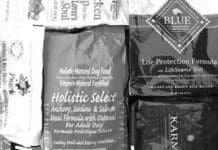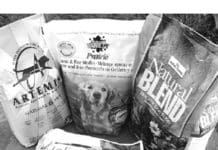Best Dog Treats
To our dogs, food is love – and security, affirmation, and reinforcement. When we give our dogs what trainers refer to as “high-value” treats – foods that are especially sweet, meaty, or pungent – our message gets through to them especially loud and clear. Behaviorists are highly appreciative of the ability of food treats to “classically condition” a dog to tolerate, and then even enjoy, environmental stimuli that he previously found frightening or threatening.
Why You Should Switch Dog Foods Frequently
Without a doubt, the most common question I am asked is What kind of food should I feed my dog?" Unfortunately
Don’t Eat the Dog’s Food
Dogs are not susceptible to the agent that causes “mad cow disease” in cattle – but cats and kibble-crunching kids could be.
Clarification: Eagle Pack Foods
Recently, we published promotional materials for WDJ (a pamphlet titled "Top Dog Foods for Total Wellness") that contained information from an article published in...
Whole Dog Journal’s 2004 Dry Dog Food Review
How do you select your dog’s food? Do you buy what your favorite veterinarian tells you to buy? Grab whatever is on sale? Feed what your dog’s breeder sent him to you with? Allow your dog to sniff the bags in the pet supply superstore and choose the one he spends the most time with? For shame! None of these methods gives your dog his best chance at eating top-quality food.
Whole Dog Journal’s 2003 Canned Dog Food Review
Can you tell the difference between a top-quality, healthy canned food, and one that can’t contribute much to your dog’s vitality or well-being? We teach you how, and offer buying suggestions.
Upgrading to a Pasture-Fed Dog Food Diet
The foundation of nearly every home-prepared diet for dogs is animal-source protein, such as beef, lamb, chicken, turkey, dairy products, or eggs. These foods are so abundant in our supermarkets that we take them for granted and assume they are nutritious. After all, our scientists, public health officials, and medical experts make no distinction between food produced by animals raised outdoors on open pasture and that of animals raised in confinement on factory farms.
Mad Cow in Dog Food?
There is no evidence that dogs can contract “mad cow disease” from eating food that was made from the rendered remains of an infected cow, say authorities from the U.S. Food and Drug Administration (FDA) and the Canadian Food Inspection Agency (CFIA). Nor is there any evidence that people could contract the disease from a dog who ate dry dog food made from infected meat.
WHOLE DOG JOURNAL ALLAYS DOG FOOD RECALL WORRIES
Dogs cannot contract "mad cow disease" from eating food that was made from the rendered remains of an infected cow.
Feeding a Vegetarian Diet
Dogs can exist as vegetarians, but making the diet complete and balanced" requires owner commitment and diligence. Tamara McFarland
Buying Treats for Your Dog – What to Look For
Nowhere in all of the gigantic field of pet supply marketing are the packages so cute and the names of the products so amusing as in the dog treat category. Many of the biggest companies use every color in the rainbow to illustrate happy dogs on the packaging – in addition to their use of artificial food colors to make the treats resemble people food such as crispy bacon, tiny hamburgers, and adorable marrow-filled cross sections of bone.
Whole Dog Journal’s 2003 Dry Dog Food Review
You should be pleased; commercial food makers are producing more good quality products. But you still have to choose the one that’s best for your dog.













